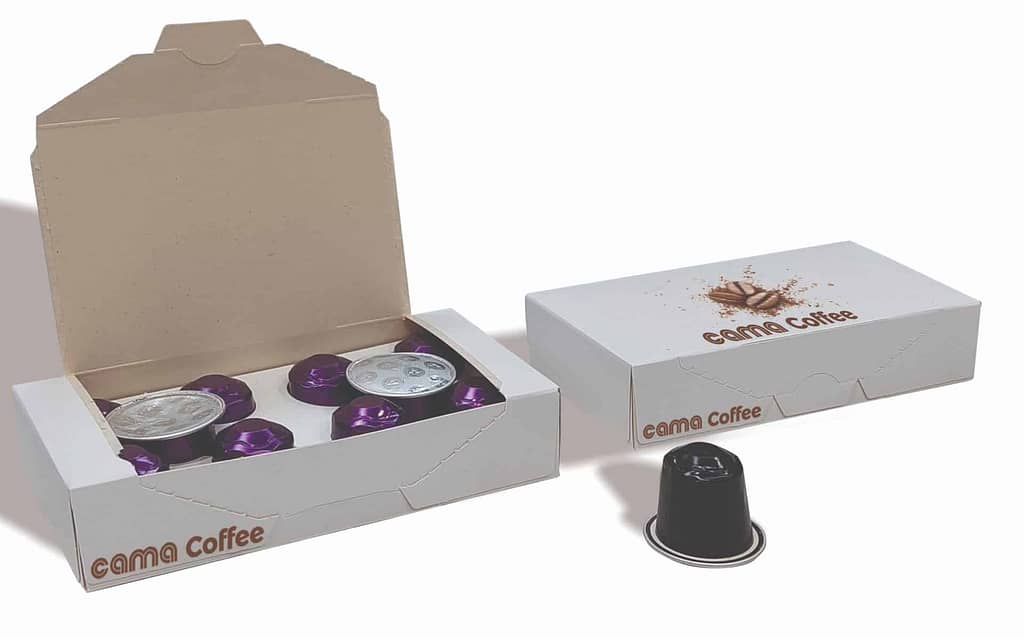[[{“value”:”Image: Cama Group
As more roasters turn to aluminium capsules, machinery suppliers must come up with new packaging formations to ensure the pods remain perfectly intact. Cama Group details its honeycomb solution.
Until recently, the bags, jars, and tins in which coffee is packaged were almost entirely functional as opposed to aesthetic, with the label often the only distinguishing feature. Except for popping the foil lid with the end of a teaspoon, there was little ceremony upon opening a fresh batch of aromatic roasted coffee.
According to the team at secondary-packaging machine manufacturer Cama Group, these days coffee suppliers want to create a story and sense of occasion, which is why modern packaging is a lot more creative, diverse, and interesting.
“The are more formats too. With capsules and pods added to the mix, suppliers are spoilt for choice with what they can achieve with their packaging designs and formats. Customers also have many more variations to choose from,” says Alessandro Rocca, Cama Group Sales Director.
Amid the boom of capsule coffee consumption, one of the more recent developments has been the aluminium capsule. Previously, plastic capsules prevailed, however, an increasing awareness of plastic pollution led to the development of a more sustainable alternative that could be recycled.
While the rise of aluminium capsules is a great thing for the environment, producers such as roasters have had to rethink the way they package their products.
“Traditional cube boxes are fine for more robust plastic pods, which can jostle into to each other during transit with very little to show for it,” says Rocca.
“Aluminium, on the other hand, is more susceptible to surface scratches and, as a result, has to be packaged differently to maintain the pristine quality look.”
The team of designers and engineers at Cama Group set about finding a solution that would not only present the pods pleasingly but ensure they didn’t get dented or damaged during transit. Their answer was the honeycomb layout, in which the capsules are arranged in a honeycomb-inspired shape and separated by a piece of card to make sure they to remain blemish free.
“Cube containers also deliver smaller surface areas for on-shelf branding, so newer designs are being developed. One is the honeycomb layout, which is where Cama Group is now setting the pace,” says Rocca.
The team at Cama Group were approached by a leading coffee company in South America that wanted a secondary-packaging machine which could box aluminium capsules in an uncommon 5 by 2 formation. As well as simply packaging the capsules, the roaster sought a solution that also maintained the visual quality.
“The coffee company required elevated overall machine efficiency in terms of operation, changeovers, and spares. Therefore, we weren’t looking to introduce a machine with a huge technical feature set, but one that could do the job efficiently, at speed, and without damaging the capsules,” Rocca says.
Cama Group’s solution for the South American roaster was its IF318 top-loader machine, which is part of its Breakthrough Generation. According to Rocca, the IF Series has design and operational features that are setting the standard in the secondary-packaging market.
Image: Cama Group
“The IF Series’ modular, scalable, and hygienically designed frameworks house contemporary automation solutions, including advanced rotary and linear servo technology, which can be tightly coupled to in-house-developed robotics to deliver the all-important flexibility and adaptability required by modern packaging operations,” he says.
“The machine range is based on a digital platform that supports full Industry 4.0 [the trend towards automation and data exchange within technology in the manufacturing space] capabilities, including augmented reality, virtual reality, and virtual testing, training, and operation.”
When the IF318 top-loaders are in operation, a robot forms cartons from blanks before another deposits four inverted capsules in a 2 by 2 formation. A five-holed spacer sheet is then added, in which the central hole accepts the final capsule the right way up to create the honeycomb format. This array is then repeated to create a 10-capsule pack and the carton is closed robotically.
“Honeycomb configurations are in very high demand, as coffee roasters copy the format from the larger suppliers. In terms of secondary packaging, it is certainly more demanding as it requires more steps,” says Rocca.
“This IF318 application was our first solution in this format, but we were able to call upon Cama Group’s years of technological expertise, significant experience of the coffee market, and the extensive capabilities of our packaging design team, all of which came together to create the perfect answer.”
With innovation at the core of the company, Cama Group is always looking ahead to future trends, modifications, and solutions for its global clients.
“Coffee companies often offer multiple formats and co-packers supply multiple customers, so flexibility is key. Future iterations of this machine will offer our legendarily fast changeover – often less than 30 minutes – from honeycomb to cube packaging,” says Rocca.
“There are lots of changes to be made, but we have developed a system that achieves these with minimum possible downtime. And, just as importantly, following changeover, the key is to ramp up production to full speed as soon as possible, which we can also do.”
Based in Italy, Rocca and the team at Cama Group work with their clients to create tailored secondary-packaging solutions for coffee companies around the world. Its coffee-packaging machine range includes coffee bag, capsule, and pod packaging machines.
For more information, click here.
This article was first published in the September/October 2024 edition of Global Coffee Report. Read more HERE.
The post The aluminium capsule conundrum appeared first on Global Coffee Report.
“}]]


